Oh the importance of the comma. These past couple days have continued the relaxation binge we’d began in Phuket – we’re more than content now to be carried luxuriously from destination to destination by various groups now, instead of driving! After arriving late in the evening at the Aoi Garden Home in central Chiang Mai, we enjoyed their cozy room, but not so comfortable apparently rock-filled mattresses only briefly before beginning a cross-town hike to our luxurious lodgings at the Tanita Guest House.
On the way, we stopped for directions (and for the free wifi) advertised at the Vegetarian Restaurant of Chiang Mai, a restaurant owned and managed by an affable chap from England named Ray. I enjoyed my vegetarian pad thai (easy to make, just leave out the chicken or prawns I guess) but Christine was more iffy on her plate of what appeared to be straw, or at least hay. Ray called out “ehya guys, lookit thisear toad I found next to the loo!” (seriously, his accent was quite thick and difficult for us Yanks to understand). “Thinkee’s alive?” he asked with some concern as he brought the toad to our table on a napkin. “Still soft…but poor bloke isn’t budgin'” he then reported sorrowfully when he set him into a small pond near us. “Sorry chap, inta the bin with you.” Good choice for breakfast conversation.
The Tanita House was a beautiful example of old Thai-style architecture, and Christine and I had an entire small house all to ourselves for $80, complete with three bathrooms, a dining room, a sitting room, and two bedrooms with queen-sized beds and balconies. Very luxurious. They also gave us a whole six pack of bottled water in the fridge downstairs, which we didn’t need and we instead distributed it out to beggars out on the street; it was a hot day. We spent the morning just walking the streets and eating, while hunting for Aeon Bank ATMs all the while, of course (still trying to avoid that $5 surcharge!). No luck finding that, but plenty of good food was had.
We had arranged an afternoon trip to the Baan Chang Elephant Sanctuary, so we were picked up around 3PM from Tanita by a private bus and driven out deep into the countryside to meet our guide and mahouts. Tan, the guide, was very businesslike and professional – he immediately had us change out of our street clothes and into blue jumpers, telling us that “by the time you’re done riding and cleaning the elephants, you would not want to smell yourselves anymore!” I believed them; the elephants out in the field a hundred meters from us were already creating a distinct perfume that permeated the air. We crossed the road and went over to them, resplendent in our blue duds, with Tan enlisting myself and a few other men to carry a couple heavy baskets filled with sugarcane and small bananas.
The elephants knew what that meant, and looked over at us expectantly, pulling gently on the chains they had tethering their feet to the ground. Each elephant had a young, dark-skinned man standing next to it, or in some cases, playfully lounging out the elephant’s back. Christine and a few other women were a bit keen to ask questions about the leg chains, as well as the metal spiked sticks that the Cambodian mahout trainers each carried. Tan drew himself up a little bit and responded a bit defensively, telling us that we needed to remember that these were not ‘pet’ elephants, nor tame elephants – this was an elephant rescue sanctuary, so all the elephants we were seeing were from bad backgrounds or cruel owners, and Ban Chaang purchases them for thousands of USD in order to give them a bit of a better life. Many of them are violent to other elephants, so they have to be restrained to prevent them from beating each other up.
Tan informed us that there were some companies that will tell tourists they don’t use the hookstick on elephants. “That might be true, but then they are hiding a spike in their palm or wrist to control the elephant, to make you think that they are different from other organizations. An elephant is not like a dog or cat or a pet; they learn that the stick stings so they will behave themselves. We only use them if we absolutely have to, but normally, showing hookstick to elephant is enough to make elephant behave.”
The elephants were oblivious to this and continued to happily stuff their faces with the food we were providing them, suggestively hooking their trunks and pointed into their open mouths. “Always put the sugar cane in sideways, not longways,” Tan instructed. “Otherwise it could get caught in their throat.” As for the bananas though, we really could just actually place it right into the elephants’ mouths – they seemed quite content, and one elephant with a set of clappers around his neck was even more content.
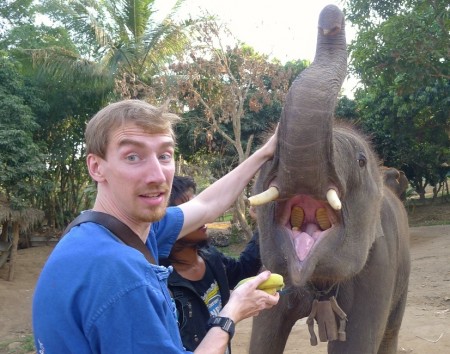
I’d never really imagined what elephant teeth looked like…as it turns out, they’re pretty different from ours!
His mahout grinned at Christine and I, and crooked his finger at us to come up right next to the necklaced elephant. The mahout called something then, and immediately a long trunk snaked around my shoulders, coiled around my neck, and kissed me on the neck with a loud sucking noise. “He’s a special case,” said Tan with a smile, watching us. “He is the only really tame elephant here; we purchased him when very young so we taught him a lot of things, and we even let him run free in the woods at night because he doesn’t damage the fences or farmers’ crops the way the others might. He wears the necklace so that we can hear him coming and going.”
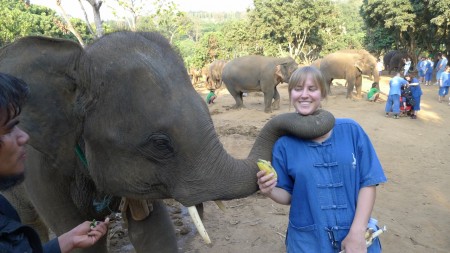
The tame elephant gives Christine a squeeze – this would probably not be covered by travel insurance!
After our baskets were empty. Tan gave us each some riding lessons on the elephants – unlike at the cheap tourist attraction in Phuket a few days ago, we would be riding bareback, so we learned some calls to get our elephants to kneel to allow a rider on and off, to go, to stop, and to turn left or ride. Bai, meaning go, would be the one I would be using a lot. However, I also wanted to ask Tan the most important command that he didn’t mention – how to congratulate our elephant for something. Tan reached up to the elephant that Christine and I were sharing and patted the knobby forehead, hard, and rubbed the spiky hairs vigorously. “You touch here, very hard, otherwise he cannot feel it. Then you say Deeeeee…deeeeee! It means, Good, good!”
Christine and I agreed after the ride that it might have a been a little long, and hard on the rump, to ride like that! She and I took turns riding the front as the driver, and rear as passenger. Without saddles to hold us in, the only adornment on the elephants for our security were long pieces of rope, wrapped around the stomach, for the rear rider – the front rider was up on the shoulder bones with their legs behind the elephant’s ears, and was fairly secure and a bit more comfortable. Going downhill was probably the worst part – I felt like I was about to fall off numerous times!
I think Christine’s favorite part was washing the elephants – at the end of the 45 minute circular ride through the jungle at twilight, we came to a resevoir about a five minute walk from the camp we had started out at. Tan, who had been walking at the head of the pack (each Mahout walked next to their elephant, but at least in our case had never really even needed to touch the elephant to control him) bade us to dismount, and the elephants joyfully ran into the water and started splashing about. “Wait a little bit,” Tan called out as we grabbed the buckets and scrub brushes nearby, “When elephants first go into the water, they almost always use the toilet so just wait a bit until we raise the dam over there to flush the dirty water out.”
All of the elephants loved the scrub brush, their trunks popping out of the water as they rolled around to touch the parts of their heads and side that we scrubbed with the brushes, I can only assume with tingly-enjoyment, and wet snorting noises emanated from the water when I dumped a few buckets of water over our elephant’s head, and Tan, who was taking pictures that he promised we would get later, snapped some pictures of us ‘surfing’ the elephants back as he lay on his side in the water.
Afterward, the mahouts led the elephants away back into the darkness, towards a series of roofed stalls that we had seen from a distance on our jungle walks, and we, the wet and smelly tourists, retired to the camp to shower and change back into our regular clothes. Dinner was also served, a nice vegetarian rice entree that Christine really liked. All and all, not bad for $80 a person – very expensive compared with any other single-day experience, but we knew that the cost to feed a single elephant was more like $200 a day, and our payment had to cover the low season’s lack of tourism as well. “All those bananas and sugar canes you fed them, that is only a treat snack,” Tan said – “their main food is corn, which we buy by the truckload every day.”
It was around 8PM by the time we arrived back in Chiang Mai, and at the suggestion of some of our fellow tourist bus riders, we headed back into the center of the city to find a Muay Thai boxing match, which was only $4 for a seat. It wasn’t until we were seated by our friendly hostess and paid for our beer that we looked and realized that most people were standing, because the match itself was free and you only needed to pay for a seat. Oh well, after riding that elephant our rears were sore, so the somewhat-padded seats were pretty nice. There were 6 fights that evening – the first two each featured some fairly young kids, looking like they were between 8 to 13 years old, and then some older kids in their late teens or early twenties boxed. There were also two fights featuring women, which was nice to see – in each case, one of the women was a foreigner (a Russian or Eastern European) by the look of her name in the program, and the other was a native Thai. Interestingly, the program listed the foreigners’ last names as “Muythaichangral” or something like that; just the name of the sport and then the name of the particular studio they were affiliated with. It was a pretty good show, especially for the price.
(It goes without saying that there was a weird little fight, like a rodeo’s clown sequence, involving a midget and a kid beating up on a fully grown man. The little guy definitely held his own, with a diabolical grin on his face, as he knocked the man’s blows away from him and pirouetted and spun about on the mat.)
We got up early the next morning for our cooking class at that Thai Cookery Centre – billed as the “first cooking school in Chiang Mai.” That seems suspect, but it was a good class none the less – we were taken first out by bus to a large covered market inside a warehouse, where vendors were selling everything from hilarious-looking pajamas with pictures of cats on them, to fried squid sauce. Jenn, our guide in the warehouse, led us from table to table, holding up various types of garlics, sprouts, and spices and shouting over the din of the market. We each had a basket given to us by the school, but we didn’t have to worry about knowing precisely what to get – a group of silent helpers flitted about the market, grabbing the things we needed and appearing at our shoulders to drop them into the basket before disappearing back into the crowds again. Very convenient; if only grocery shopping was that easy all the time!
Back at the actual school itself, we selected our 3 items of choice to cook out of 21 different options – I selected a Penang Curry paste, Pad Thai (I was already deeply missing Ton’s delicious cooking back at The Between Restaurant), and a spicy noodle soup. They had a wok for each of us; no sharing here, and Christine went off with a different group to try her hand at fried spring rolls and other items which I look forward to sampling someday! The school apparently had a policy on no video of the presentations; they are probably rightfully worried that all of their instructions will be posted on Youtube otherwise. There wasn’t much time for pictures though – once again, I was impressed by the expert handling of tourists that Thais seem to have – we were whisked skillfully and efficiently through all of our courses, but at the same time, we never felt truly rushed. The tedious bits were taken out of our hands by the silent helpers who came around to our woks and pink trays every few minutes, setting an egg in here or a spring of green garlic there. All we had to do was basically throw the ingredients in the oil in the wok, and stir like crazy!
And of course, we got to eat the results of our cooking, too – I loved my Pad Thai, and thanks to the cookbook that they gave each of us, I think I’ll be able to when I get home. Christine was rightfully proud of her spring rolls too, although I ate the one that she offered me without the tamarind sauce that she had also made to go with it, therefore missing out on part of the full experience.
Just like that, it was time for us to catch the afternoon (and night) train from Chiang Mai down to Bangkok. For the first time, we rode one of the tricycle-like tuktuks from the Tanita House to the train station, which only cost us 60 baht, or 2 dollars. The pollution that we had been warned about didn’t even seem so bad – but where we’re going, in Bangkok, I bet it will be a lot worse!
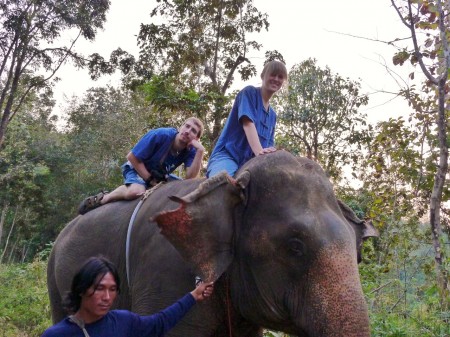
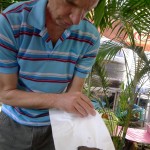
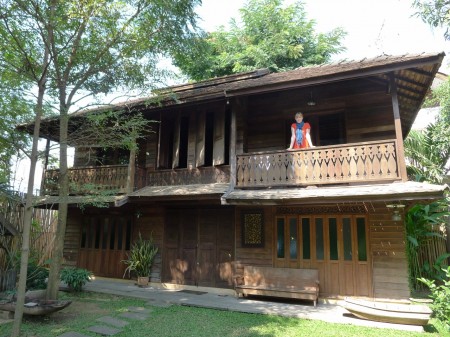
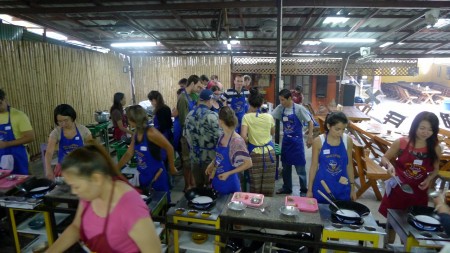
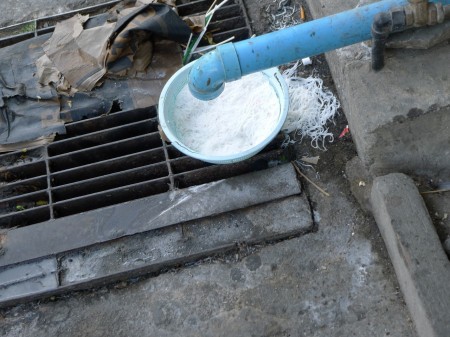
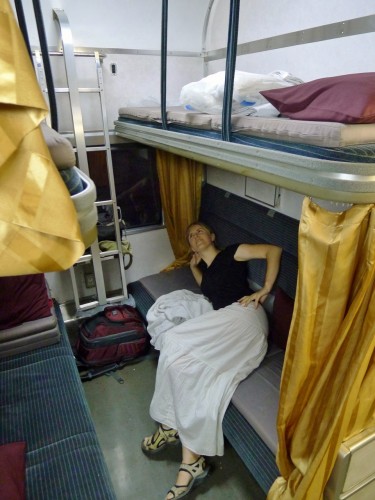


Look forward to sampling your (and/or Christine’s) new Thai cooking prowess! You may recall that the “Thai in da Box” restaurant across Papanui St from my hotel in Christchurch was by far my favorite place to eat there — from your account, Ton must be a similar maestro of the kitchen!
Was the trick we learned in Wadi Rum for camel riding (ie, with one leg sort of drawn up under oneself) of any use on the elephants?
Ray’s “deceased” toad actually looks pretty normal in the enlarged photo (ie, the way he’s holding his limbs close to his body), making me wonder if he wasn’t just playing dead.